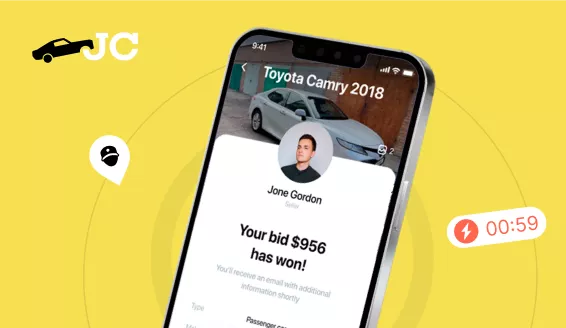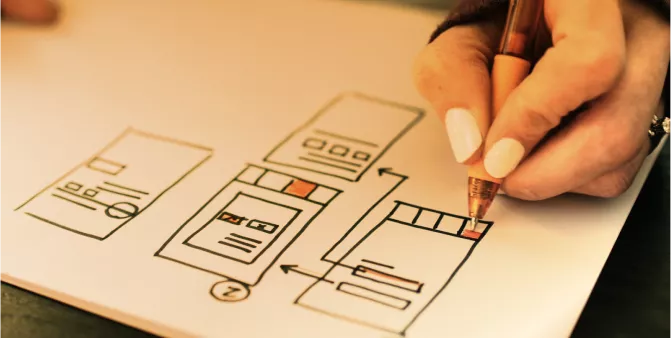Today users are constantly interacting with mobile and desktop devices, digital products and other individuals on these platforms. We call these interactions “touchpoints”. To better understand CJMS, it is important to understand the potential touchpoints users encounter before making a purchase. Let's take a closer look at these touchpoints using a grocery delivery app as an example.
Which touchpoints can we find in this scenario?
1) Marketing materials: various customer reviews of the platform, physical and digital advertising, links to the platform on various search engines like Google. Basically everything that can potentially connect a user with your digital product from before making their first order.
2) The delivery app/website itself
3) The user portal within the app
4) The interaction between a customer and the delivery person when receiving their order (this is also an integral part of the product)
5) The order's packaging
6) Customer service (if the custom runs into an issue or a question)
7) Loyalty program
8) The company's social media
Why did a potential customer leave an app after scrolling through the product catalog for nearly an hour? Why does one user complete their order just in 3-4 clicks, and the other fiddle around with the same app, without making a purchase?
A CJM helps you understand your customers and answer all these questions.
A Customer Journey Map visually displays how users interact with products. It shows all available user touchpoints and what exactly happens at each touchpoint.
To put is simply, CJMs demonstrates the process a customer goes through from the time he/she becomes aware of a need to the time they fulfill this need (a.k.a. make a purchase). It also helps businesses view their products from the customer's point of view.
A simplified example of a delivery service CJM
In order for the CJM to solve the company's goals, not only is it necessary to take into account possible interactions between the client and the product, but also consider the history and prompting leading to the desired end result - a purchase.
Additional questions needed to consider:
— how the user first learned about your product
— the customer's first impression of the product or company
— why did the customer choose you: the factors behind their decision to choose to work with you
— the reason why the consumer chose your product
Why do we need to understand CJMs?
To introduce new features successfully—> CJMs help you bring the client closer to the key goal of new features.
To perfect current features —> CJMs help teams identify and solve the problems that customers encounter when using your product.
Problems that CJM solves
CJMs aren't drafted not work for the sake of CJM. In order to achieve tangible business results, CJMs must serve certain business objectives. Here are some of them:
1. CJMs develop a continuous user experience — each and every touchpoint motivates customers to move further down the buyer path.
For example, faster user logins via Face ID instead of a OTP. in your online banking app2. Removes obstacles and increases desired results - more customers reaching your end goal.
3. Increases customer loyalty. They return to the product because it is obstacle-free and easy to use.
4. It helps identify weak spots that are not being addressed properly and, as a result, are putting the user experience at risk.
5. CJMs are an effective source of information for your team. CJMs provide a bird eye view of your product performance and can be used to initiate product enhancement discussions between teams and departments.
What does it take to create a CJM
1. Identify Key Problems
CJM begins with identifying the problems your team faces.
Let's look at some common scenarios:
— High Customer churn and low-conversion rates
— New product or a feature releases
— Understanding customer choice patterns
— Issues properly delegating responsibilities among teams
2. Create a team
Once you have identified issues, you need create a team to research these. Product owners, project managers, designers and market analysts can join the CJM development team.
3. Identify your characters
The CJM is not for users "at large" — your target audience may be too heterogeneous. CJMs are developed with one key customer persona in mind ( with the most common traits, needs, behavior found in your target audience).
If you work with several user groups, then you need to develop CJM for one each of these. The characteristics separating one persona type from another may vary from CJM to CJM. However, we can identify some main identifiers:
— Customer: age, gender, marital status, income, goals, key motivations behind purchases
— Their Environment: when and where the customer interacts with the product
— Common Tasks: what tasks the user performs and how often
4. Interview your customers
That step helps you find out the most important things from a large amount of miscellaneous and siloed information about your target audience. You can include the following questions:
— How did you find out about us/our product?
— Why did you choose our product?
— What goals do you want to achieve using our product?
— How often do you use the product?
— Would you recommend this product to friends/family?
— Do you use the product regularly?
5. Develop your metrics
The next step is to think about the metrics you'll use to track track CJM efficiency. Some options would be:
— Customer satisfaction surveys
— Retention or churn rates (retention and churn rates)
— Revenue metrics
6. Decide where to do CJM
— Manually, on stickers
— Miro
— Storiesonboard
— Figma
What does a CJM consist of
For example, let us take a bank with advanced online services. The bank has a feature — you can order a bankcard for your kid via a mobile app. The issue here is low conversion rates.
Let us say we created a persona. It is a female. Here is her profile:
• She is 35+ years old
• Her child is 8+ years old
• Her monthly income on average is 5500 USD
• She lives in a urban city
• She does a lot of online shopping
• Financially savvy
• She wants her child to learn financial responsibility
Let us take this particular example to learn what a CJM consists.
1. Touchpoints and channels of interaction
The team identifies all potential touchpoints between the buyer persona and the product. In order to make sure that all non-inevident interactions are duly covered, you can try the suggested journey yourself.
Next, the team identifies the channels for customer interaction for each touchpoint. E.g., an order form, social media, advertisement and commercials, a call from customer helpline. As well as off-line channels — interaction with couriers, a visit to the office.
2. What happens at each touchpoint: actions, thoughts and emotions
The CJM is developed based on what your users do, think and feel while using the product. This information can be obtained from high quality field research as well as diary methods.
The details vary depending on the purpose of the CJM, but here is what you definitely need to capture:
— What the customer wants when using the product
— What could be the ideal scenario of each interactions (with examples) — What problems and obstacles a client may face at each touchpoint — What measures should be taken to avoid barriers — What does a person feels during interaction.
3. Solving user problems
CJM is created to identify gaps in the user experience and thereafter take measures to optimize it. E.g., to cut a long application form short or simplify a legal text.
4. CJM Visualization
All the data obtained is to be visualized in a convenient way: in Miro or Figma, on a whiteboard or in a PDF file.
After that, all we need to do is to write down the problems and appoint people in charge to solve them.
Download the CJM template
Rules for efficient CJM development
1. Define the business purpose of your CJM
CJMs must be beneficial for your business and solve a specific problem. To do this, you need to answer the following questions:
— What is the business goal of your CJM?
— Who will use the CJM and what for?
— Who is your audience and what experiences are you appealing to?
2. Use multiple sources of information
It is impossible to build a truthful CJM if you use one source of information or only interview loyal users. During a face-to-face conversation, a person may forget the details or will not be able to convey all the emotions and experience regarding your product. And don't forget that not all people will be honest and sincere. They may be too shy to tell the truth so as not to offend you.
3. Communication with the product team
As a rule, one team member is in charge of leading the CJM development process. As part of this, it is important to keep in touch with all employees who in one way or another are involved in product development.
This will help to avoid a situations when CJMs are developed only based on the experience of a person who is engaged in its development.
4. Precise and operational recommendations
Let us say you have found all the issues a customer encounters while achieving a goal. Make sure that the solutions to these problems are practical, not superficial. "Improve the design of our catalog" is too abstract a recommendation and will not help your team improve user experience.
5. Regular updates
The situation in the world can change rapidly, as well as the moods of product users. To keep abreast and timely improve the customer experience, you need to update your CJMs regularly.
In today's day and age, people expect to get the best experiences from online services. According to the study, only 1 out of 26 unsatisfied customers leave complaints on a regular basis, others just stop using the product. It turns out that about 91% of consumers leave silently, and the business looses valuable feedback.
This research helps to enhance the importance of CJMs. To improve your services, you need to understand your customers. And to understand customers, you need to draft a map of their journey.




